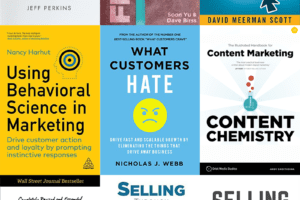Episode 21 of The Verblio Show
Andy Crestodina quite literally wrote the book on content marketing.
His work, “Content Chemistry,” has been dubbed “The most practical book ever written about digital marketing” by marketing legend Jay Baer, and he shares a wealth of that same practical, hands-on expertise in this conversation.
He talks with Steve about how content marketing shouldn’t require a years-long slog before it gives results, and the steps you can take to get returns before you even hit publish. He also discusses what is—and isn’t—thought leadership, the problem with best practices, and a variety of insightful tidbits on productivity, analytics, and the concept of “zero waste marketing.”
Guest-at-a-Glance
Name: Andy Crestodina
What he does: CMO and co-founder of award-winning web design company Orbit Media Studios. He’s also the author of “Content Chemistry,” the go-to book for content marketers, and has been the keynote speaker at more than 100 conferences nationwide.
Find him on the web: Orbit Media | LinkedIn | Twitter
Get smart: “Best practices are really just good hypotheses that should be tested.”
Top Tips From This Episode
Practice “Zero Waste Marketing”
If you view content marketing as giving away tons of information for free over a long time in the hopes that some of your readers eventually will become customers, it sounds impractical. With Andy’s concept of “zero waste marketing,” however, you can get value from your content both during the creation process and long after it’s published.
Use your content as a way to start conversations by reaching out to cold leads for contributor quotes. By making your process collaborative, you’ll both improve your content and create allies for promotion and sharing. And, once it’s published, that content will stick around—unlike ads. Reference it, send it to new prospects, and improve it over time. Repurpose content to get value from it in different ways: podcasts become blog posts, blog posts become videos, and all of it can be used for sales collateral or training materials.
Best practices aren’t “best”
“Best practices are only useful in the absence of first party data,” Andy says. They’re not necessarily the best practices for a particular company, a certain industry segment, a specific audience, or for you or your client’s unique goals.
In the hierarchy of what should be driving your decisions, opinions are the lowest, followed by best practices, and then first party data analytics. The top dog? A live A/B split test in real-time, with two versions of the same content shown to the same audience.
Want to be a thought leader? Take a stand
Andy breaks down the three ingredients of thought leadership: having a personal brand, being a subject matter expert, and being an opinion leader. Content marketers may have a brand and provide useful, knowledgeable content as subject matter experts, but that isn’t thought leadership if they aren’t also willing to speak out for and against things.
He tells it like it is: “If no one’s ever disagreed with you and your content, you’re probably not really doing thought leadership.” Thought leadership is driven by strong beliefs and opinions, which sets it apart from purely informative content. “I think thought leadership as a definition should require that the person is not necessarily controversial, but taking a stand,” Andy says.
Episode Highlights
As Eugene Schwartz said, “Content is not written. Content is assembled.”
“How much time do you spend writing? Maybe a third. Really, I feel like a lot of it is just like assembling pieces. Putting it together, engineering an outcome by carefully combining the elements that will make it work for promotion.”
Don’t content market alone.
“If you write an article and you leave out contributor quotes or expert input from different points of view, you’re missing the chance to improve the content. You’re missing the chance to get greater social reach because an ally in creating content is an ally in promoting it. They’re very likely to share. And you’re also missing a chance to grow your personal network and enjoy the process.”
Write a book piece by piece…
“Make the outline first and think about all the things that you know on a topic… Then each article can be a building block in what will later be turned into a larger piece of content like a book. You can do it quicker if you take four articles on a similar topic and put those first into an ebook or a guide. So imagine you’ve got 50 articles. … Can you turn those into four different guides? Great job. Can you turn those guides into a longer format, printed, self-published piece? Great job. You can build up to it.”
…and consider your lifetime body of work.
“Everyone is creating slowly a lifetime body of work. It’s just the more structured, organized thinker with a bunch of forethought and a plan, a vision, of future outcomes—we do the outline first and then build that lifetime body of work in a directional way so that it’s going to lead to that… You’re engineering a final outcome.”
Use analytics the right way.
“The purpose of analytics is to know which things to double down on and which things to stop doing. It is a decision support tool: don’t use it for reporting. Use it to make decisions about where to invest much, much more and what to quit doing because good stuff is 10x the bad stuff. It’s not good and bad like something’s a little bit better—it’s good and bad like some things are amazing and some things are worthless.”
Not everyone will agree with you.
“To publish a strong opinion is difficult for a lot of brands. I think the formula there is to ask yourself, what are people in my industry afraid to talk about? What questions are they afraid to ask or answer? What do I think might happen that other people don’t think will happen? If you begin to publish this kind of content, you’re gonna sound very different. You’re gonna be putting yourself out there… Some people will disagree with you.”
Running an agency? Better love people.
“You have a team of people working for the common goal…but the team always has a new player on it, which is the client. So if the goal is to make success predictable by reducing all variables, there’s a giant wild card that you can’t really take off the table and that is the client themselves. So the reason you’re playing the game is to have this one, sometimes crazy member on your team, right? This client. So it’s fun. It is beautiful. It is challenging.”
Top Quotes:
Andy:
[9:24] “Advertising is temporary, content marketing is forever.”
[13:54] “The job is not just to answer all of your prospect’s questions, but it’s to raise questions they didn’t think of asking and answering those.”
[21:20] “All these people who we think of when we think of thought leaders—no one delegated that job to them. They all chose themselves.”
[25:02] “There’s a reason why there aren’t giant web dev companies. It’s a low margin labor of love.”
[25:41] “Best practices are really just good hypotheses that should be tested.”
[28:12] “Would sports be fun without a scoreboard? No, it would be kind of boring. … One thing that happens is when you measure things, your motivation increases. Your interest in that thing increases.”



